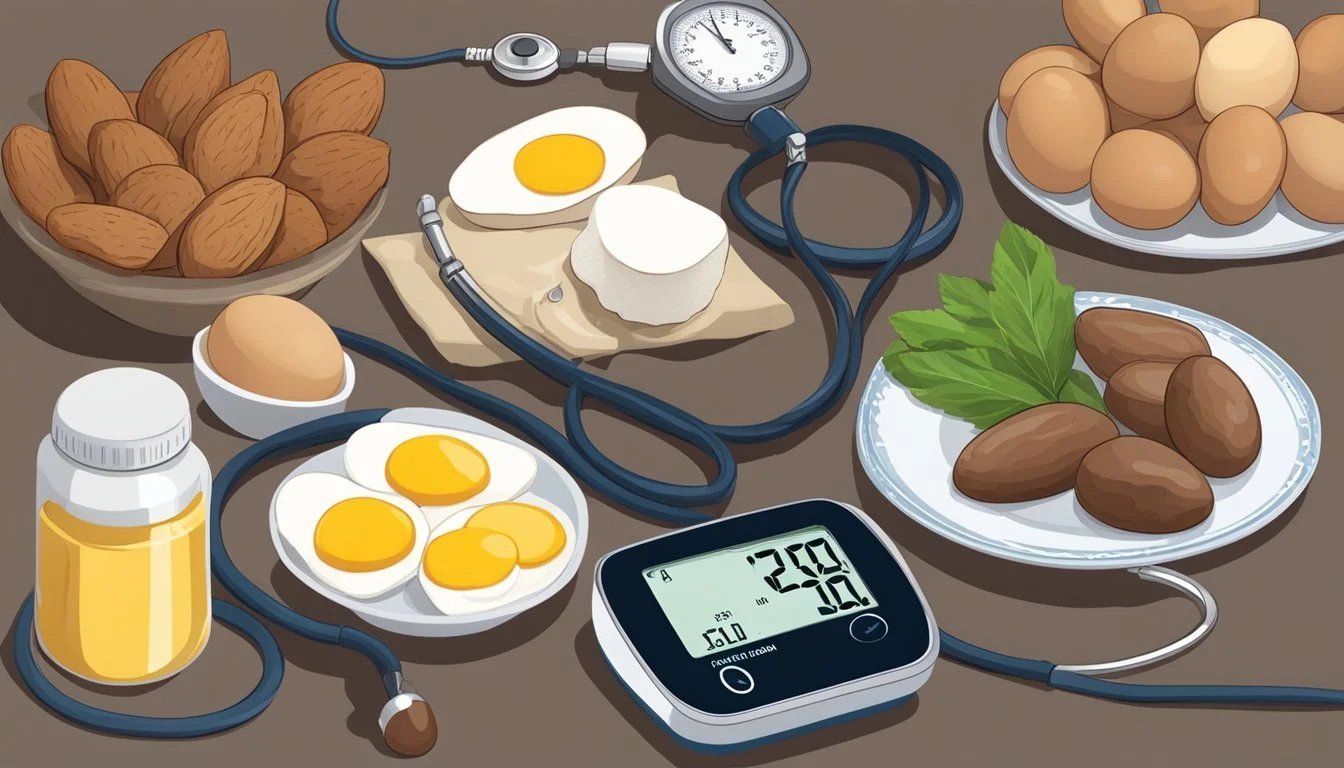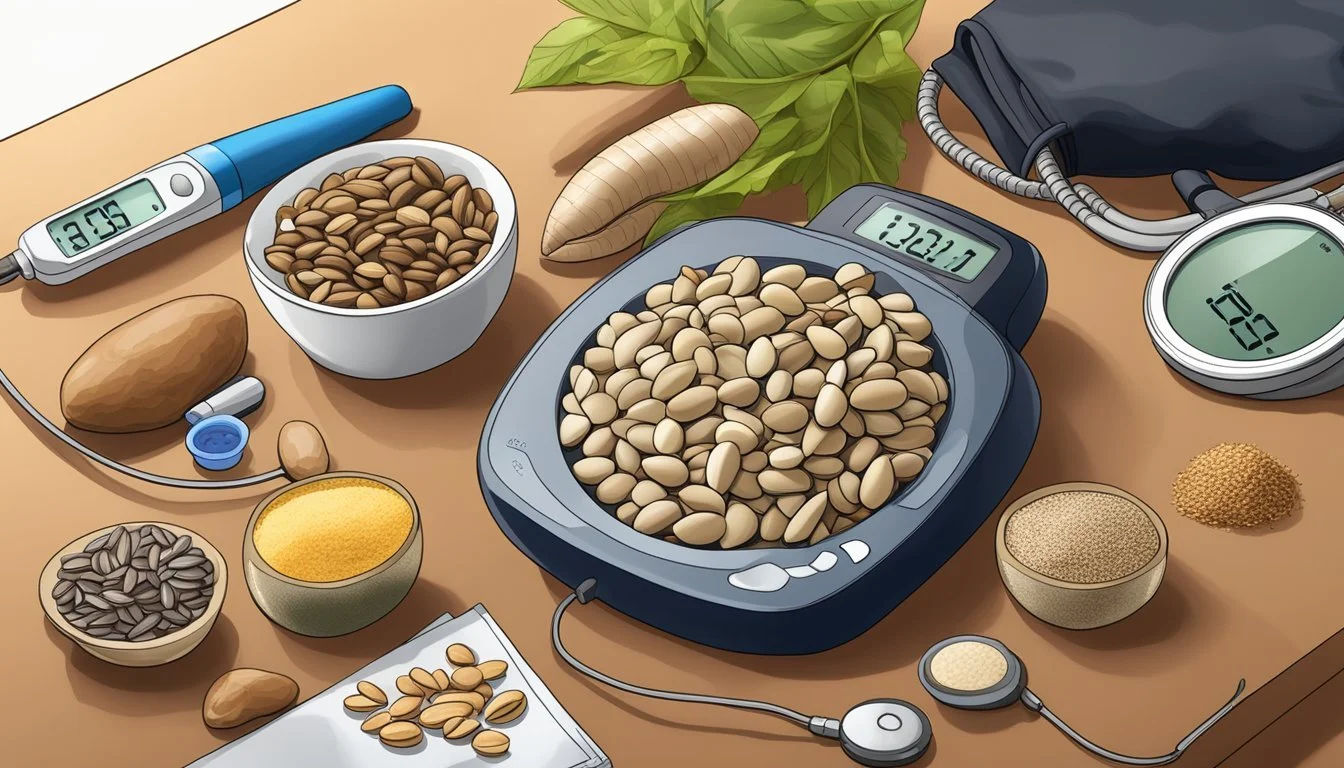What Are Some Good Sources of Selenium for Managing Hypertension
A Nutritional Guide
Selenium is an essential trace element, recognized for its critical role in various biological functions, including acting as an antioxidant defense mechanism within the body. Its importance in health and disease has been highlighted by research suggesting that selenium may influence cardiovascular health, particularly in the prevention and management of hypertension—a condition affecting a significant portion of the global population. By contributing to the body's antioxidant systems and potentially affecting blood pressure regulation, adequate selenium intake is considered beneficial for those managing hypertension.
Good sources of selenium are predominantly found in a varied diet. Foods rich in selenium include nuts, particularly Brazil nuts, seafood such as fish and shellfish, meats like beef and poultry, eggs, and certain grains. As individuals look for dietary strategies to support their cardiovascular health, incorporating these selenium-containing foods could be an integral part of managing hypertension effectively. It is important, however, to balance selenium intake, as both deficiency and excessive levels can have adverse health implications.
Selenium and Hypertension
Selenium is a trace element implicated in various biological functions related to cardiovascular health, including blood pressure regulation, potentially impacting hypertension management.
Role of Selenium in Cardiovascular Health
Selenium acts as a cofactor for the enzyme glutathione peroxidase, an essential antioxidant that helps minimize oxidative stress, a key contributor to cardiovascular disease. It has been suggested that higher selenium levels in the body may enhance this enzymatic defense system, thereby supporting overall cardiovascular health. Adequate selenium status is particularly crucial for thyroid hormone metabolism, immune system function, and may also play a role in preventing certain cancers.
Impact of Selenium on Blood Pressure
Studies examining the impact of selenium on blood pressure have yielded inconsistent results. Serum selenium concentrations have been variously reported to have inverse, null, or positive associations with hypertension. A systematic review and meta-analysis integrating data from various studies could offer a more comprehensive understanding of how selenium influences blood pressure. However, the exact relationship remains to be fully determined, as selenium might affect blood pressure control and potentially aid in the prevention of hypertension through its interaction with oxidative stress and antioxidant systems.
Dietary Sources of Selenium
Selenium is an essential mineral with a key role in maintaining overall health and supporting cardiovascular function. Its natural presence in foods can vary greatly, influenced by the mineral content of the soil in which plants are grown or the diet of animals.
Animal-Based Sources
Animal-based food items are reliable providers of selenium and can be incorporated into the diet to manage hypertension. Here is a list that highlights selenium content in various animal-derived foods:
Fish: Yellowfin tuna (92 mcg/3 ounces), sardines, oysters, clams, halibut, shrimp, and salmon are excellent sources.
Meat: Poultry and beef typically contain selenium, but the exact amount can be dependent on the feed.
Eggs: Commonly included in diets and are a good source of selenium.
Plant-Based Sources
Plants absorb selenium from the soil, making their selenium content highly variable. Some plant-based selenium sources include:
Brazil Nuts: Extremely rich in selenium (544 mcg/ounce or 6-8 nuts).
Grains and Breads: Often fortified with selenium in many regions.
Vegetables and Fruits: Contain lesser amounts; however, they can contribute to overall selenium intake.
Selenium-Rich Regions
The amount of selenium in foods depends on the concentration of selenium in the soil where the food is grown. Certain geographical regions tend to have higher soil selenium levels which in turn leads to higher selenium content in the local produce and livestock.
Recommended Daily Intake
For optimal health, specific selenium intake is recommended:
Adults should aim for a daily intake of 55 micrograms (mcg).
Upper limits are set at 400 mcg/day to prevent toxicity.
Consuming a balanced diet with a variety of selenium sources can help support adequate selenium intake for those managing hypertension.
Selenium Supplements and Regulation
Selenium is an essential trace mineral that can be taken as a dietary supplement to potentially manage hypertension. It is critical to understand the types of selenium supplements available, their regulation, and the risks associated with selenium toxicity.
Types of Supplements
Selenium supplements are available in both organic and inorganic forms. The two common organic forms are selenomethionine and selenocysteine, which are generally considered more bioavailable—that is, the body can absorb and utilize them better than inorganic forms like selenite or selenate.
Organic selenium is often found in:
Selenomethionine supplements
Dietary sources such as Brazil nuts, fish, and eggs
Inorganic selenium options include:
Selenite powders
Selenate in some multivitamin/mineral supplements
Regulatory Aspects
In the United States, the Food and Drug Administration (FDA) does not require dietary supplements to be approved before they are marketed. However, manufacturers are responsible for ensuring their products are safe and that any claims made about them are substantiated by adequate evidence.
Manufacturers must comply with current Good Manufacturing Practices (cGMPs)
Labelling requirements include:
Serving size
Amount of selenium per serving
Recommended daily intake
Selenium Toxicity Risks
While selenium is essential for health, excessive intake can lead to toxicity. Selenium toxicity, known as selenosis, can cause symptoms such as:
Hair and nail brittleness and loss
Skin rashes
Nausea and other gastrointestinal disturbances
Nervous system abnormalities
It is essential that individuals do not exceed the upper limit of selenium 400 micrograms per day for adults. For those managing hypertension, it is imperative to consult with a healthcare provider before starting any selenium supplementation, especially given the risks of toxicity and the fact that the amount of selenium in various supplements can vary widely.
Interaction with Other Trace Elements
Selenium (Se) is an essential trace element that plays a crucial role in maintaining human health, particularly in the context of hypertension. Its function is enhanced and modulated by the presence of other trace elements such as copper (Cu) and zinc (Zn). Both elements are central to antioxidant activities that protect the body from oxidative stress—a factor implicated in hypertension.
Selenium and Copper
Copper is a component of various enzymes that act as antioxidants, and selenium complements this role through its incorporation into selenoproteins. The balance between copper and selenium is vital as imbalances could lead to disrupted antioxidant defense mechanisms. For example:
Excessive copper relative to selenium might inhibit some enzymes that depend on selenium, potentially affecting blood pressure regulation.
Conversely, sufficient selenium levels might help ensure the proper function of copper-dependent enzymes, such as ceruloplasmin, which plays a role in iron metabolism.
Selenium and Zinc
Similarly, zinc is another trace element that works closely with selenium to maintain a healthy antioxidant status within the body:
Both selenium and zinc are essential for the optimal activity of superoxide dismutase (SOD), an enzyme fundamental in combatting oxidative damage.
Zinc deficiency may affect the metabolism of selenium in the body, evidencing the interdependent relationship between these trace elements.
Adequate intake of these nutrients, in tandem, is particularly relevant for managing hypertension, suggesting that strategies to maintain a balanced intake could be beneficial for blood pressure control.
Clinical Studies on Selenium and Hypertension
Research into the relationship between selenium intake and hypertension has utilized a variety of study designs, with the majority focusing on the association rather than establishing causation.
Randomized Controlled Trials
Randomized controlled trials (RCTs) investigating selenium and hypertension have provided insights yet yielded variable findings. RCTs are the gold standard in clinical research for determining the efficacy of medical interventions. In the context of selenium's effect on blood pressure, these trials evaluate changes in serum or plasma selenium levels and subsequent blood pressure measurements to determine if supplementation has a noteworthy effect on hypertension.
Prospective and Cross-Sectional Studies
Prospective studies, which follow participants over a period to observe outcomes like the development of hypertension, often coupled with cross-sectional studies that assess selenium levels at a single point in time, have contributed to the understanding of selenium's potential role in public health. Data from the National Health and Nutrition Examination Survey (NHANES) have been particularly valuable, providing a large and diverse dataset for analysis.
Sample Size and Study Parameters
Sample size is crucial for the statistical validity of clinical studies. Meta-analyses, which aggregate data from many studies, help to clarify the effects by increasing overall sample size. The parameters, such as participant demographics, baseline health status, and the form and dosage of selenium supplements, are meticulously defined to strengthen the study's scientific rigor and relevance to public health.
Mechanisms of Action
Selenium, a vital mineral for human health, influences hypertension through its role in various biochemical pathways, especially those related to oxidative stress and lipid metabolism.
Antioxidant Properties
Selenium is a key component in the body's antioxidant defense system. It contributes to the reduction of oxidative stress, a condition characterized by an imbalance between the production of free radicals and the body's ability to neutralize them. Oxidative stress is implicated in the pathogenesis of hypertension. Selenium, as a cofactor for antioxidants, helps mitigate this stress, thereby exerting a potential effect on blood pressure regulation.
Impact on Glutathione Peroxidases
Selenium is integral to the activity of glutathione peroxidases (GPx), a group of enzymes that protect cells from oxidative damage. Glutathione, a tripeptide molecule, is a substrate for GPx enzymes, which convert harmful peroxides into non-toxic molecules. Optimal selenium levels ensure efficient GPx function, and this enzyme system is critical for neutralizing lipid hydroperoxides and hydrogen peroxide, thus helping to maintain normal blood pressure.
Effect on Blood Lipids
Elevated serum lipids are a recognized risk factor in the development of hypertension. Selenium might influence hypertension by modulating blood lipid levels. It has been shown that appropriate selenium intake can affect the lipid profile by reducing serum lipids, such as cholesterol, which in turn may contribute to the maintenance of normal blood pressure. However, selenium's exact effects on lipid metabolism in humans require further research for a complete understanding.
Health Outcomes Related to Selenium
Selenium, an essential trace mineral, plays a pivotal role in multiple health outcomes, including the management of hypertension. Deficiencies or excesses in selenium intake can lead to significant health effects, particularly related to cardiovascular diseases, diabetes, and other chronic conditions.
Cardiovascular Disease and Mortality
Selenium's antioxidant properties contribute to its potential in reducing the risk of cardiovascular disease (CVD) and associated mortality. Studies suggest that optimal selenium levels can have a protective effect against coronary heart disease. Research indicates a U-shaped relationship with cardiovascular health, where both selenium deficiency and excess can lead to heart complications.
Keshan Disease: A selenium-deficient condition characterized by myocardial necrosis, leading to heart failure.
Coronary Heart Disease: Adequate selenium status is related to a reduced risk of coronary heart disease and subsequent heart failure.
Selenium's Role in Diabetes
Selenium influences glucose metabolism, and its role in diabetes management is complex:
Insulin Sensitivity: There is evidence that adequate selenium levels can help improve insulin sensitivity and may play a role in preventing or managing diabetes.
Glycemic Control: While selenium may contribute to glycemic control, extreme levels, high or low, have been associated with an increased risk of type 2 diabetes, reflecting the importance of balanced selenium intake for diabetes outcomes.
Other Health Impacts
The role of selenium extends beyond cardiovascular disease and diabetes:
Gastric Cancer: Some evidence aligns sufficient selenium intake with a potentially lower risk of gastric cancer, but further research is needed to unequivocally establish this relationship.
General Mortality: Selenium status has been inversely associated with overall mortality, suggesting that maintaining adequate selenium levels can be beneficial for longevity.
Mood Disorders: There is a growing body of research exploring the impact of selenium on mood disorders, though conclusions are yet to be definitive.
Selenium's effect on human health is broad and nuanced, underscoring the need for a balanced dietary intake within recommended guidelines to support various bodily functions and potentially mitigate certain disease risks.
Factors Influencing Selenium Status
Selenium status in humans is influenced by various elements that range from the bioavailability in different food sources to geographical variations in soil selenium content. Understanding these factors is crucial for dietary planning, especially in the context of managing health conditions like hypertension.
Bioavailability in Foods
Diet plays a pivotal role in selenium status as selenium is primarily obtained through food. Foods rich in selenium include nuts, specifically Brazil nuts, various types of seafood, meats, cereals, and dairy products. However, the bioavailability of selenium in these foods can be vastly different. The form of selenium, whether it is selenomethionine, found in plant-based foods, or selenocysteine, found in animal foods, affects its absorption and utilization in the body. Typically, the selenomethionine form found in grains and Brazil nuts is more readily absorbed.
Impacts of Cooking and Processing
The preparation and cooking of selenium-rich foods can alter selenium levels. For example, processing grains may reduce selenium content, while cooking methods like boiling or roasting can affect selenium retention in vegetables and meats. Individuals focused on selenium intake for health management should consider the impact of culinary practices.
Geographical Variations
Selenium levels in soil can influence the amount of selenium that enters the food chain, thereby affecting the nutrition content of crops and animal products. For instance, in the US population, it is noted that certain regions, particularly the Midwest and parts of the West, have soils with higher selenium concentrations. Conversely, some European regions have low soil selenium levels, which may impact the local population's selenium status and subsequently, their diet and health.
Addressing Selenium Deficiency
Selenium deficiency is linked to various health issues, including hypertension. Addressing this deficiency requires accurate identification, effective treatment strategies, and comprehensive public health policies.
Identification and Diagnosis
Detecting selenium deficiency involves evaluating dietary intake and, if needed, testing serum selenium levels. Individuals with low dietary selenium consumption may manifest signs that warrant a closer examination for deficiency. Symptoms associated with severe selenium deficiency include muscular weakness, heart abnormalities, and even thyroid dysfunction.
Treatment Strategies
For those diagnosed with selenium deficiency, a multipronged approach is advised:
Diet: Incorporation of selenium-rich foods such as Brazil nuts, seafood, eggs, and whole grains.
Supplementation: Selenium dietary supplements can be considered, especially for populations with restricted access to selenium-rich foods. However, supplements should be taken under medical guidance as excess intake can be toxic.
Monitoring: Regular monitoring of serum selenium levels is crucial to prevent both deficiency and excess.
Public Health Policies
Public health initiatives are essential in preventing selenium deficiency across populations. These policies include:
Nutritional Education: Programs to raise awareness about foods high in selenium and their health benefits.
Food Fortification: Adding selenium to common foods can help increase the overall selenium intake of the general population.
Access to Varied Diet: Ensuring the availability and affordability of a variety of foods that are natural sources of selenium.
By combining effective diagnosis, strategic treatment, and robust public health efforts, individuals and populations can manage selenium levels effectively, thus preventing potential adverse health outcomes related to selenium deficiency.
Conclusion
Research has consistently highlighted selenium as an essential trace element, important for various bodily functions including acting as an antioxidant and supporting thyroid hormone metabolism. In terms of hypertension, the relationship between selenium intake and blood pressure regulation has been explored, although findings are not definitive.
One can obtain selenium from several dietary sources. For individuals looking to manage their nutrition with an emphasis on selenium, here are some sources:
Brazil nuts
Seafood (tuna, halibut, sardines)
Organ meats (liver)
Poultry
Fortified foods
It is important for public health messaging to encourage a balanced intake of this trace element, as both deficiency and excess of selenium have been associated with health issues. Those managing hypertension should prioritize a well-rounded diet, rich in a variety of nutrients, while paying attention to their selenium intake.
Selenium's role in cardiovascular health remains a subject of ongoing study, and further research is needed to conclusive insights. Individuals should consult healthcare professionals before making significant changes to their diet, particularly when managing conditions such as hypertension. Proper nutrition is a cornerstone of good health, and selenium is one part of the tapestry that composes a healthy diet.








